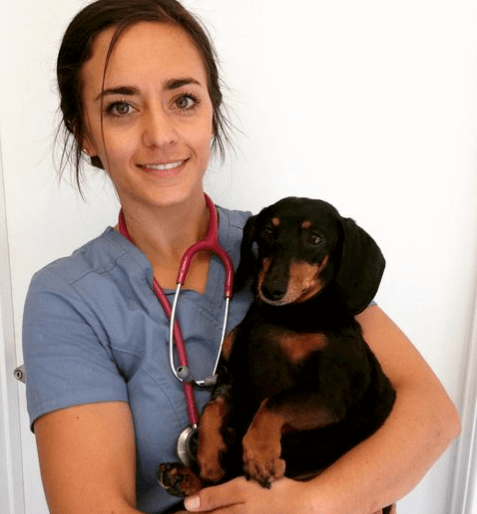🦴 Updated on July 8th, 2023

Part of a dog’s appeal is its soft, silky fur. For centuries, humans have been drawn to the look and feel of a beautiful dog, even breeding towards specific aesthetic goals. Naturally, both of our species benefit when there’s petting involved!
Golden retrievers have some of the most luxurious coats in the canine kingdom. Ranging from a bright and sunny yellow to rusty maroon, the colors of golden retrievers’ coats are dazzling, and the consistency of their fur is oh-so-pettable. Some coats grow straight, while others have a wave to them.
Keeping Summers Cool
When the weather gets warmer, it seems to make sense that if I shave my golden retriever it will help keep them cool. After all, people tend to chop our locks for the same reason.
So, can you shave a golden retriever? As I learned, there’s more to this process in regards to a dog than I thought – and compelling reasons not to follow that potentially harmful idea.
Keep reading to learn about a dog’s coat, ideal grooming habits, and more.
A Golden Retriever’s Coat
Your golden’s fur may look different depending on what type they are – English, American, or Canadian. Even within these types, there are variations in fur color, texture, and consistency. However, for purposes of shaving, all goldens can be grouped into one category.
There are multiple layers, functions, and textures of fur just on one dog’s body. Typically, the coat doesn’t reach its full length or thickness until the dog matures around two years old, or sometimes even longer for larger breeds.
Some medium-sized breeds, such as greyhounds, dalmatians, and boxers, have a single-layered coat that feels thin and sleek. You can clip this type of coat down almost to the skin (though not usually necessary) and it will grow back uniformly.
Others, such as golden retrievers, have a more complex makeup to their fur. Read on to learn about this special case.
Parts of the coat
A dog has three types of hair that can grow from one follicle:
- Guard hair – the coarsest top layer that we feel when we pet them
- Intermediate hair – medium length hairs that fill out the coat
- Undercoat – the dense, inner layer of “fluff” that lies closest to the skin
The undercoat serves a very important purpose to dogs – temperature regulation. This layer of fur insulates them from both cold and heat, protecting the skin and helping them stay comfortable in inclement conditions. It also discourages the reach of ticks and other irritating bugs.
Dogs with undercoats typically shed or “blow it out” a couple of times per year, usually along with seasonal changes. For golden retrievers, this happens in spring and fall. You may find little pieces of cottony fur drifting around the house or yard like tumbleweeds.
During this time, it helps keep your house clean – and speeds up the shedding process, helping your dog feel more comfortable – if you brush them thoroughly every day.
Even though most people think of double-coated dogs as the snow breeds, such as huskies, golden retrievers display this feature too. The important thing to remember is that the makeup of their coat is a natural structure, and we shouldn’t mess with it.
How Fast Does a Dog’s Hair Grow
The normal growth cycle of dogs’ fur is about 130 days, depending on the breed. It does go through a dormant period when first cut down, then picks up speed. Once it comes back in, it grows at a rate of about a half-inch per month, or six inches per year – same as human hair.
This means that if you shave your golden, it could feasibly take many months, or even half a year, for them to regain that thick coat they had. By then, you’ve already passed the next shedding season, and the coat hasn’t had time to return to its conventional shedding patterns.
Sometimes, when a dog moves from one temperature zone to another, its coat will adjust to fit its new environment. This means that if you adopt a golden retriever in Florida and then move to the Midwest, a few winters in that climate could show a difference in its fur thickness and growth pattern than when you first brought them home.
Can You Shave a Golden Retriever?
Let’s cut right to the chase: Don’t do it! Ultimately, shaving any dog’s coat is a bad idea unless recommended by a vet for health reasons – but this would be rare for a double-coated breed.
Why It’s a Bad Idea
As we have seen, the different layers of fur help in temperature regulation in dogs with double coats. If you shave them, it throws a wrench into the natural texture as well as the growth cycle and could harm your dog’s health over time.
On top of safety reasons, there’s the aesthetic to think about. When a shaved dog’s fur comes back in, it won’t be pretty – just ragged and uneven.
Single-coated breeds are the only ones for whom shaving is a legitimate option. Professional groomers spend significant time learning how to give certain breeds their “look” (poodles and Shih Tzus come to mind).
An at-home grooming session isn’t usually a good idea anyway, but especially for a double-coated dog who doesn’t need to be shaved.
Spot Shaving at the Vet
You may be thinking of a time that your golden retriever went to the vet for something like a surgical procedure and the dog came back with a portion of their leg, neck, or belly shaved. We just learned that this is bad to do – so why does the vet do it?
The difference at the vet is that the shaving is done for health and sanitary reasons. Performing a procedure that involves cutting into the skin means that hair could irritate or infect the area.
To avoid complications, the vet sometimes shaves a patch of hair before sterilizing the place where the incision will be made.
Keep in mind also that for most procedures, the shaving will only cover a very small area. This will grow back in a matter of a few weeks or a couple of months, and be hardly noticeable. This is nothing like shaving the dog’s entire coat!
Golden Retriever Grooming Styles
So, if you shouldn’t shave them, what can you do to take care of your pup’s luxurious hair? There are styles of coats that you can choose to make them look and feel their very best.
Be sure to follow up each grooming session with a thorough brushing to remove flyaways and attain the sleekest look possible.
Keep reading to gather ideas for your groomed golden retriever!
Simple Cut
Just like it sounds, this option is the most basic. No fancy shapes or techniques are necessary here – just lightly trim all around. Some feathering can look nice around the neck and chest.
This cut retains the authentic growth of the golden’s coat and doesn’t require any special training to implement.
Show Cut
This cut is not too different from the simple cut, except that more attention is paid to smaller areas as if you were going to show your golden retriever. Extra trimming is encouraged around the groin, chest, ears, and especially the legs and paws for a more streamlined look.
Teddy Cut
If you really do want your dog’s hair shorter, but without sacrificing the double coat, the teddy cut may be a good choice. With clean lines and an extra fluffy look, this is a favorite of many golden retrievers owners.
Shear the tail, scissor the legs, then simply trim the coat all over for a rounder, fuller look that makes your golden resemble a teddy bear!
How to Groom a Golden Retriever
Regardless of what haircut you decide for your golden, there are other parts of grooming that you should carry out regularly. Nail trimming, ear cleaning, and brushing help them stay balanced, clean, and happy.
Alternative Ideas to Beat the Heat
We have learned that a shaved golden retriever is not a happy one. However, that doesn’t mean your pup has to suffer in the warm weather! There are plenty of things you can do to help them be comfortable when the outdoor temperatures soar.
- Shelter – Never leave your golden exposed to the sun without someplace to go for shade. Natural protection like trees or shrubberies, or a doghouse structure, help them find relief from the midday heat.
- Water – Always make sure there is ample water available so they can be refreshed.
- Ice snacks – Freeze water, beef broth, or other liquid treats for your dog to nibble on.
- Kiddie pool – Many water dogs, including retrievers, love to splash around. If you can handle the mess, this is a great way to keep your dog cool and entertained.
- Car rides – Your pup may love to hang their head out of the window while you run errands, but summer is the time it’s probably best to leave them at home. Trapping them in an enclosed vehicle while you pop into a store is a big no-no.
- Heatstroke – Though you should take proper caution long before it’s an issue, it’s still a good idea to educate yourself on the signs of heatstroke in a dog.
Never shave your golden retriever. Instead, make them comfortable in ways that don’t involve removing their coat, and both you and your pup will be happy and healthy in the warm season.


